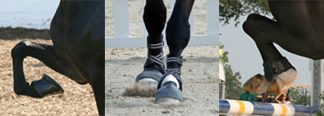If your horse wears shoes, you’ve probably had one go missing at some point. Horse shoes often get stuck in the mud and twist off. If your horse has a long stride, he can pull a front shoe off with his back hoof. Or if it’s been a while since his last visit from the farrier, one may simply come loose.
When your horse loses a shoe, it is important to act quickly to protect the hoof from injury or breakage.
 First, examine the hoof and look for partially broken or uneven pieces of hoof. Using a farrier’s rasp, file down any sharp pieces of hoof that may cause further damage. |
 If you are going to turn your horse out before the farrier can replace the shoe, you should bandage the hoof for extra padding and protection. Medium-sized diapers provide just the right amount of padding and are easier to use than sheet cotton. Wrap the diaper over the hoof so most of the padding covers the sole. |
 Secure the diaper by wrapping elastic bandage all the way around the hoof. |
 Wrap the entire bandaged hoof in duct tape. This will secure the bandage and provide an added layer of durability. |
If your horse roams many acres of pasture, finding the shoe may be a challenge. However, it is important to search for the wayward shoe because the attached nails now pose a threat to your horse and all his turnout buddies.
A lost shoe is an almost inevitable inconvenience that comes with horse ownership, but if you know the steps to take, you’ll have no problem protecting your horse’s hooves.
Learn how to keep your horse’s hooves healthy and strong with 8 Hoof Care Myths.






Very helpful as I have a horse who is getting a few abscesses and I need this type of help. Than you 🙂
You shouldn’t bandage above the coronary band because this will cut off circulation. The bandage should be rolled back and the coronary band exposed. E
Great info. Thanks
You can bandage the coronary band, but wrap cotton around it first so the blood flow is not restricted.
The photo showing Duct tape above the hairline freaks me out. I would never advise that. Particularly for beginning horseman who may wrap too tightly. I would use the duct tape ONLY below the hairline and on the ground surface. The vet wrap could go above the hairline but I would not wrap above cotton, ever.
Never a good idea to wrap above the coronet band. You’re better off packing the foot with a poultice, slapping a cotton pad/gauze or even kitchen paper towels on the bottom, and wrapping with vetrap to about 3/4 inch below coronet. Then tape with duct tape to about 1/4 below coronet band.. Having that 1/2 inch of duct tape adhered to the hoof will help the wrap stay just a little bit better
I enjoyed the article, however, I’d like to see how to cover the BACK hoof. I have a hard time, holding the hoof & getting the duct tape to where it needs to be. Also, if you are trying to put a poltice paste on the back heel, is there a way to keep it there, before you get the diaper in place? LOL I’m not cordinated or quick.